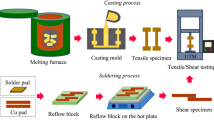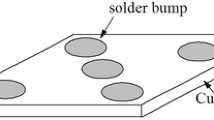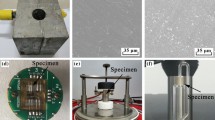Abstract
Solder is widely used for electrical interconnections in electronics, and its use involves the melting and subsequent solidification of the solder. This paper reports for the first time the effect of the cooling rate in solidification on the electrical behavior (conduction and dielectric behavior) of the solidified solder. Prior work addressed the effect of the cooling rate on the microstructure and mechanical properties only. The solder is Sn-4Ag (lead free, melting temperature 221 °C). Cooling is from the melt at 230 °C. Comparison of the cooling rates corresponding to air cooling and ice-water quenching indicates that the microstructure is much finer and the resistivity (DC) is higher by 2.4% for the quenching case. However, the permittivity (100 kHz) is the same for the two cooling rates. This means that the microstructural refinement associated with the quenching decreases the mobility without affecting the carrier–atom interaction responsible for the permittivity. The carriers are the valence electrons. Since the polarization associated with the permittivity involves the interaction of a fraction of the valence electrons with the atoms, this further implies that the fraction of carriers that interact with the atoms is not affected by the microstructural refinement and that the decrease in mobility (as indicated by the resistivity increase) does not affect this fraction. The fractional increase in the resistivity due to the quenching (relative to air cooling) during solidification (this work) is small compared to that due to the mild heating of the solid solder to 70 °C (our prior work). The mild heating also does not affect the permittivity.




Similar content being viewed by others
Data availability
Data and material are available by contacting the corresponding author.
References
H. Lee, K. Huang, Effects of cooling rate on the microstructure and morphology of Sn-3.0Ag-0.5Cu solder. J. Electron. Mater. 45(1), 182–190 (2016)
L. Snugovsky, P. Snugovsky, D.D. Perovic, J.W. Rutter, Effect of cooling rate on microstructure of Ag-Cu-Sn solder alloys. Mater. Sci. Technol. 21(1), 61–68 (2005)
X. Wang, Y.C. Liu, C. Wei, L.M. Yu, Z.M. Gao, Z.Z. Dong, Effects of composition and cooling rate on the microstructure of Sn-3.7Ag-0.9Zn-Bi solders. Appl. Phys. A 96(4), 969–973 (2009)
X. Li, F. Zu, W. Gao, X. Cui, L. Wang, G. Ding, Effects of the melt state on the microstructure of a Sn-3.5%Ag solder at different cooling rates. Appl. Surf. Sci. 258(15), 5677–5682 (2012)
L.R. Garcia, W.R. Osorio, A. Garcia, The effect of cooling rate on the dendritic spacing and morphology of Ag3Sn intermetallic particles of a SnAg solder alloy. Mater. Des. 32(5), 3008–3012 (2011)
F. Ochoa, J.J. Williams, N. Chawla, Effects of cooling rate on the microstructure and tensile behavior of a Sn-3.5wt.%Ag solder. J. Electron. Mater. 32(12), 1414–1420 (2003)
F. Ochoa, J.J. Williams, N. Chawla, The effects of cooling rate on microstructure and mechanical behavior of Sn-3.5Ag solder. JOM 55, 56–60 (2003)
J. Shen, Y. Liu, Y. Han, H. Gao, C. Wei, Y. Yang, Effects of cooling rates on microstructure and microhardness of lead-free Sn-3.5%Ag solders. Trans. Nonferrous Metals Soc. China 16(1), 59–64 (2006)
N. Murad, S.R. Aisha, M. Ishak, Effects of cooling rates on microstructure, wettability and strength of Sn3.8Ag0.7Cu solder alloy. Procedia Eng. 184, 266–273 (2017)
J.G. Maveety, P. Liu, J. Vijayen, F. Hua, E.A. Sanchez, Effect of cooling rate on microstructure and shear strength of pure Sn, Sn-0.7Cu, Sn-3.5Ag, and Sn-37Pb solders. J. Electron. Mater. 33(11), 1355–1362 (2004)
K.S. Kim, S.H. Huh, K. Suganuma, Effects of cooling speed on microstructure and tensile properties of Sn-Ag-Cu alloys. Mater. Sci. Eng. A 333(1–2), 106–114 (2002)
T.H. Chuang, L.C. Tsao, C. Chung, S.Y. Chang, Evolution of Ag3Sn compounds and microhardness of Sn3.5Ag0.5Cu nano-composite solders during different cooling rate and aging. Mater. Des. 39, 475–483 (2012)
K.N. Prabhu, P. Deshapande, Satyanarayan, Effect of cooling rate during solidification of Sn-9Zn lead-free solder alloy on its microstructure, tensile strength and ductile-brittle transition temperature. Mater. Sci. Eng. A 533, 64–70 (2012)
E. Cadirli, H. Kaya, M. Sahin, Effects of cooling rate and composition on mechanical properties of directionally solidified Pb100-xSnx solders. J. Electron. Mater. 40(9), 1903–1911 (2011)
R. Mahmudi, M. Pourmajidian, A.R. Geranmayeh, S. Gorgannejad, S. Hashemizadeh, Indentation creep of lead-free Sn-3.5Ag solder alloy: effects of cooling rate and Zn/Sb addition. Mater. Sci. Eng. A 565, 236–242 (2013)
F. Ochoa, X. Deng, N. Chawla, Effects of cooling rate on creep behavior of a Sn-3.5Ag alloy. J. Electron. Mater. 33(12), 1596–1607 (2004)
K. Wu, N. Wade, J. Cui, K. Miyahara, Microstructural effect on the creep strength of a Sn-3.5%Ag solder alloy. J. Electron. Mater. 32(1), 5–8 (2003)
R. Mahmudi, A.R. Geranmayeh, H. Noori, N. Jahangiri, H. Khanbareh, Effect of cooling rate on the room-temperature impression. Mater. Sci. Eng. A 487(1–2), 20–25 (2008)
E.S. Gouda, Effect of cooling rate on structure and creep behavior of Sn-0.7Cu-0.5Zn lead-free solder alloy. Eur. Phys. J. Appl. Phys. 48(2), 20902/p1-20902/p5 (2009)
R. Mahmudi, A.R. Geranmayeh, S.R. Mahmoodi, A. Khalatbari, Effect of cooling rate on the room-temperature indentation creep of cast lead-free Sn-Bi solder alloys. Phys. Status Solidi A 204(7), 2302–2308 (2007)
Z. Mei, J.W. Morris Jr., M.C. Shine, T.S.E. Summers, Effects of cooling rate on mechanical properties of near-eutectic tin-lead solder joints. J. Electron. Mater. 20(8), 599–608 (1991)
M. Mueller, S. Wiese, M. Roellig, K. Wolter, Effect of composition and cooling rate on the microstructure of SnAgCu-solder joints. IEEE Electronic ComponentsTechnol. Conf. 57th(Vol. 4), 1579–1588 (2007).
M. He, Z. Chen, G. Qi, C.C. Wong, S.G. Mhaisalkar, Effect of post-reflow cooling rate on intermetallic compound formation between Sn-3.5 Ag solder and Ni-P under bump metallization. Thin Solid Films 462–463, 363–369 (2004)
B. Chiou, J. Cheng, Effect of the cooling rate on the mechanical and electrical behavior of a 63Sn/37Pb solder bump on a metallized Si substrate. J. Mater. Sci. Mater. Electron. 5(4), 229–34 (1994)
W. Yang, L.E. Felton, R.W. Messler Jr., The effect of soldering process variables on the microstructure and mechanical properties of eutectic Sn-Ag/Cu solder joints. J. Electron. Mater. 24(10), 1465–1472 (1995)
J. Sigelko, S. Choi, K.N. Subramanian, J.P. Lucas, T.R. Bieler, Effect of cooling rate on microstructure and mechanical properties of eutectic Sn-Ag solder joints with and without intentionally incorporated Cu6Sn5 reinforcements. J. Electron. Mater. 28(11), 1184–1188 (1999)
K. Hardinnawirda, A.M.Z. Akhtar, I.S.R. Aisha, I. Mahadzhir, A review on the effect of surface finish and cooling rate on solder joint reliability. WIT Trans. Built Environ. 166, 201–212 (2017)
P. Darbandi, T.R. Bieler, F. Pourboghrat, T. Lee, The effect of cooling rate on grain orientation and misorientation microstructure of SAC105 solder joints before and after impact drop tests. J. Electron. Mater. 43(7), 2521–2529 (2014)
J.J. Sundelin, S.T. Nurmi, T.K. Lepistoe, E.O. Ristolainen, Mechanical and microstructural properties of SnAgCu solder joints. Mater. Sci. Eng. A 420(1–2), 55–62 (2006)
D. Yao, J.K. Shang, Effect of cooling rate on interfacial fatigue-crack growth in Sn-Pb solder joints. IEEE Trans. Comp. Packag. Manuf. Technol. Part B 19(1), 154–165 (1996)
H.A. Jaffery, M.F.M. Sabri, S. Rozali, M.H. Mahdavifard, D. Shnawah, Effect of temperature and alloying elements (Fe and Bi) on the electrical resistivity of Sn–0.7Cu solder alloy. RSC Adv. 6, 58010 (2016)
A.K. Pal, P. Sen, Resistivity and temperature coefficient of resistivity of tin films. J. Mater. Sci. 12(7), 1472–1476 (1977)
X. Xi, D.D.L. Chung, Piezoresistivity and piezoelectricity, dielectricity discovered in solder. J. Mater. Sci. Mater. Electron. 30(5), 4462–4472 (2019)
W. Yang, D.D.L. Chung, Electric polarization and depolarization in solder, and their effects on electrical conduction. J. Mater. Sci.: Mater. Electronics, in press.
W. Yang, D.D.L. Chung, Effect of temperature on the electrical conduction and dielectric behavior of solder. J. Mater. Sci.: Mater. Electronics, in press.
X. Xi, D.D.L. Chung, Role of grain boundaries in the dielectric behavior of graphite. Carbon 173, 1003–1019 (2021)
R.E. Franklin, Crystallite growth in graphitizing and non-graphitizing carbons. Proc. Royal Soc. London 209(1097), 196–218 (1951)
R.E. Franklin, The structure of graphitic carbons. Acta. Crystallogr. 4, 253–261 (1951)
D.D.L. Chung, Self-sensing concrete: from resistance-based sensing to capacitance-based sensing. Int. J. Smart Nano Mater. (2020). https://doi.org/10.1080/19475411.2020.1843560
A.A. Eddib, D.D.L. Chung, First report of capacitance-based self-sensing and in-plane electric permittivity of carbon fiber polymer-matrix composite. Carbon 140, 413–427 (2018)
X. Xi, D.D.L. Chung, Piezoelectret-based and piezoresistivity-based stress self-sensing in steel beams under flexure. Sensors Actuators A 301, 111780 (2020)
Funding
This work was supported in part by New York State Department of Economic Development via New York State Center of Excellence for Materials Informatics.
Author information
Authors and Affiliations
Corresponding author
Ethics declarations
Conflict of interest
Yang and Chung declares that they has no known competing financial interests or personal relationships that could have appeared to influence the work reported in this paper.
Additional information
Publisher's Note
Springer Nature remains neutral with regard to jurisdictional claims in published maps and institutional affiliations.
Rights and permissions
About this article
Cite this article
Yang, W., Chung, D.D.L. Effect of the cooling rate in solidification on the electrical behavior of solder. J Mater Sci: Mater Electron 32, 7867–7874 (2021). https://doi.org/10.1007/s10854-021-05511-7
Received:
Accepted:
Published:
Issue Date:
DOI: https://doi.org/10.1007/s10854-021-05511-7




